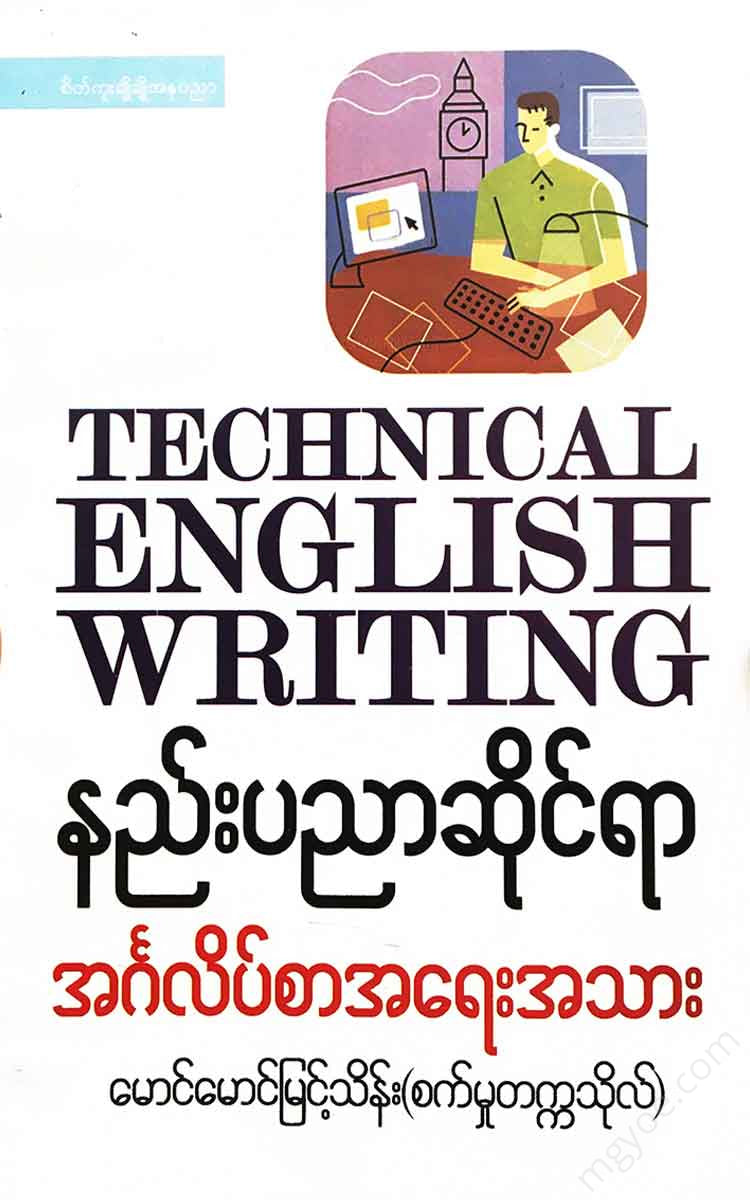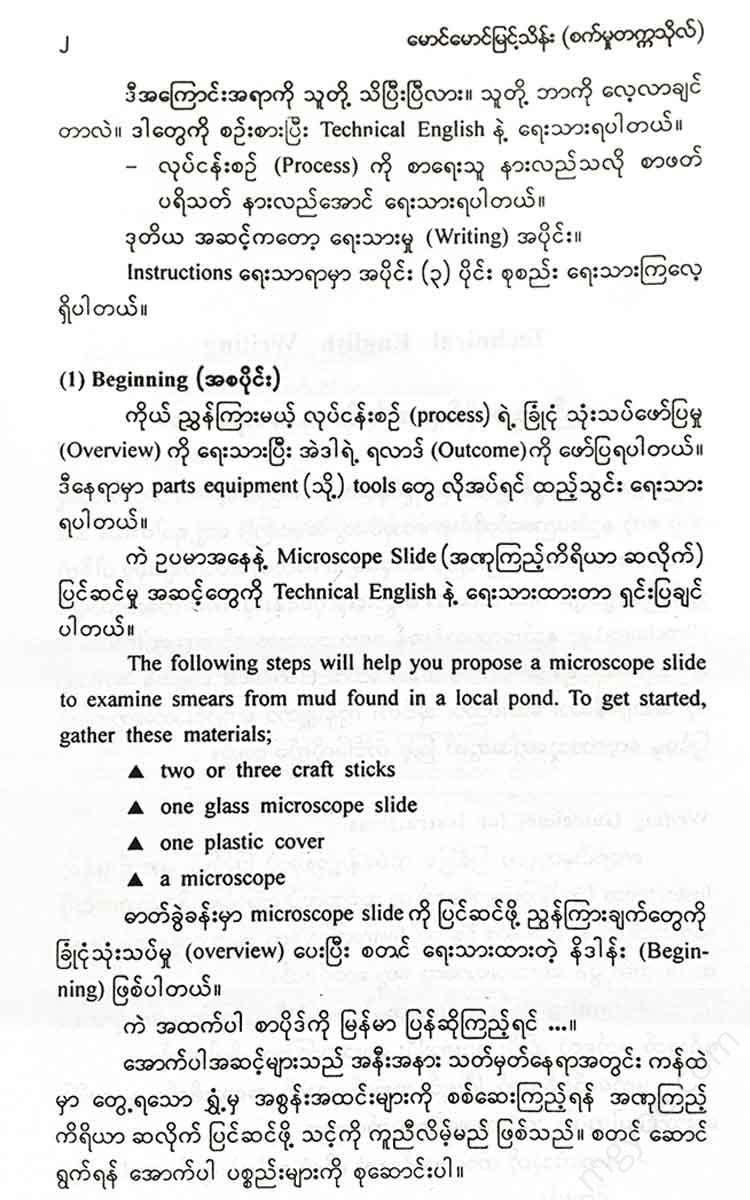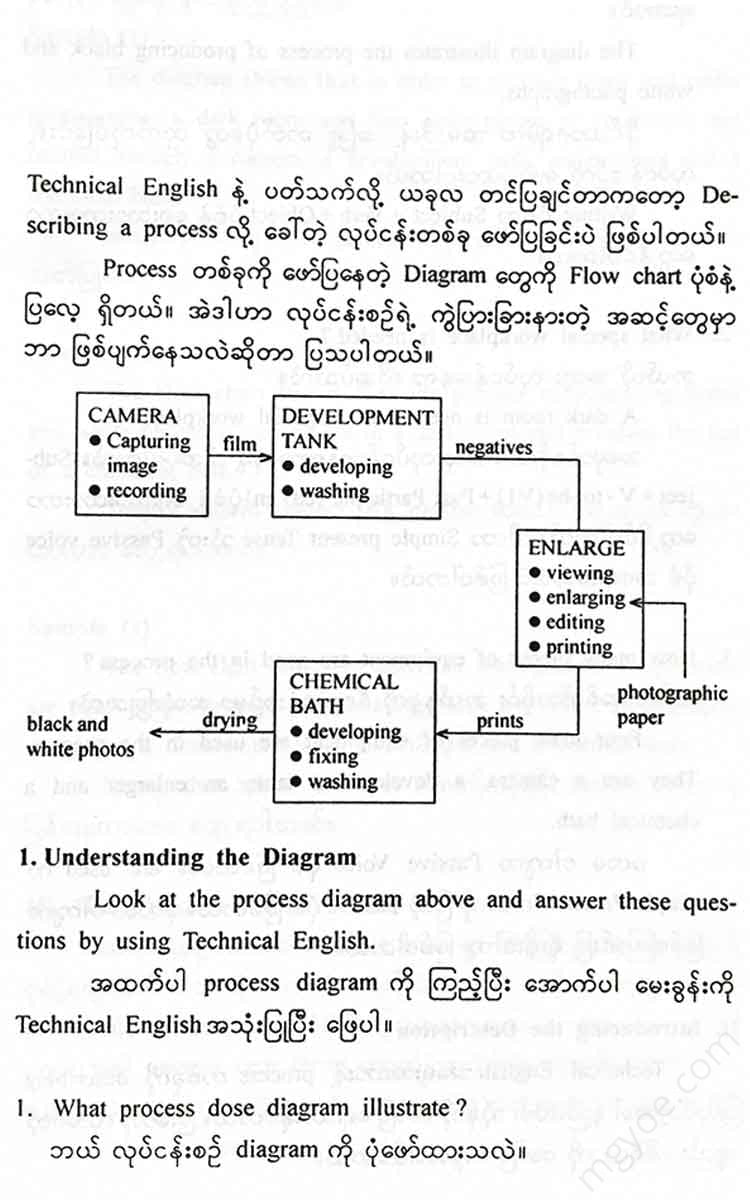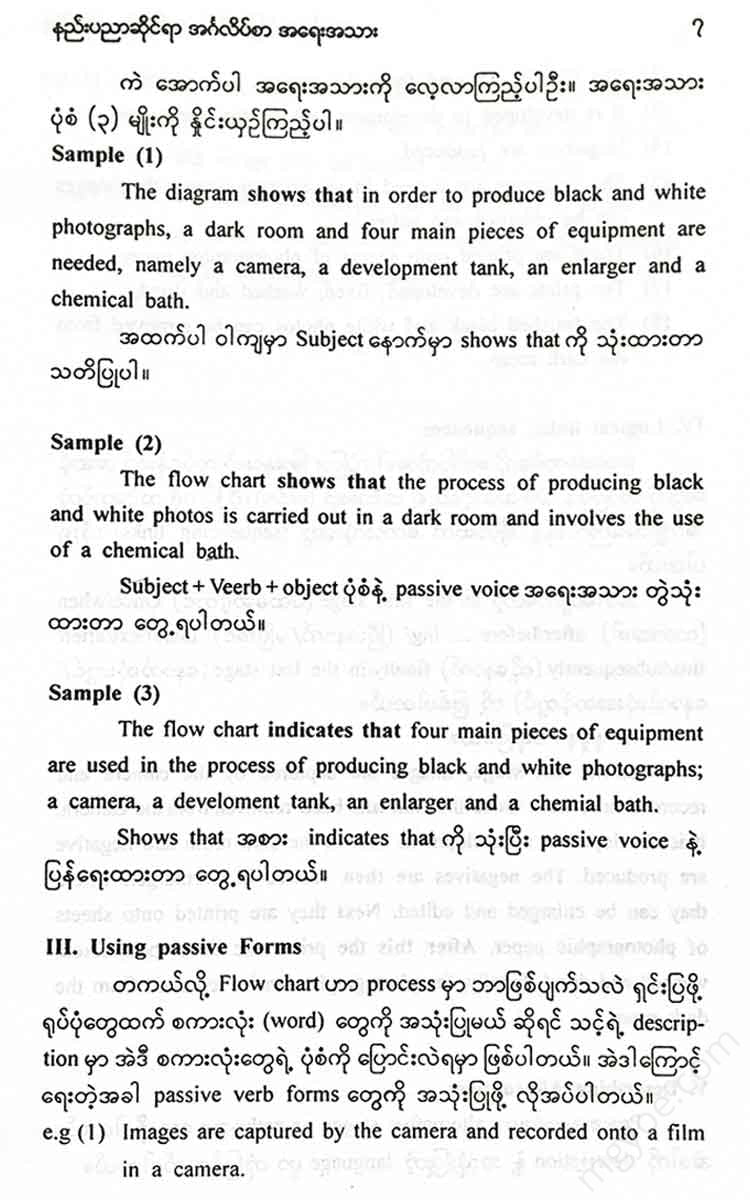စိတ်ကူးချိုချိုစာပေ
Maung Maung Myint Thein (University of Technology) - Technical English Writing
Maung Maung Myint Thein (University of Technology) - Technical English Writing
Couldn't load pickup availability
Technical English Writing
Technical English Writing
Nowadays, there are many books on technology in computer, engineering, medicine, IT, science, and applied science. Among them, school technology books, instructions in catalogs , and business catalogs ( brochures) are written in a technical style. This Technical English Writing is prepared for engineering, medicine, IT, and computer students as well as for outsiders.
Writing Guidelines for Instructions
Whether in schools or in the workplace, good instructions can help you succeed and stay safe at work . So, you will find systematic guidelines written in instructions.
Prewriting is often done by thinking about which audience will read these instructions.
After the audience reads, you can describe the details . That information should include:
- It has a goal of what you want to give the reader .
Do they know this topic? What do they want to learn? Think about these and write in Technical English.
- The process should be written in a way that the reader can understand as well as the writer. The second stage is the writing part.
When writing instructions, they are usually written in three (3) sections.
(1) Beginning
Write an overview of the process you will be directing and describe its outcome . You can include parts, equipment , or tools if needed.
Now, for example, I would like to explain the steps for preparing a microscope slide in Technical English.
The following steps will help you propose a microscope slide to examine smears from mud found in a local pond. To get started, gather these materials;
. two or three craft sticks
. one glass microscope slide
. one plastic cover
. a microscope
The Beginning is an introduction that provides an overview of instructions for preparing microscope slides in the laboratory.
Now, if we translate the above paragraph into Burmese...
The following steps will help you prepare a microscope slide to examine the mud stains found in a pond in a nearby area. Gather the following materials to get started.
A stick, two or three sticks, that can be handled with the hand.
A microscope slide.
A plastic cover.
A telescope.
In the middle of the body, you can use imperative verbs to guide readers through the necessary details step-by-step . You can number the steps.
An example of an imperative verb is "go away."
Now , I want to describe the steps in the body of the text for the microscope slide preparation that I just explained. Note that I have written it with imperative verbs.
- Carefully wash and dry the glass slide and the cover. Put the slide and cover on a clean, dry surface.
Wash the glass slide and coverslip thoroughly and dry them. Place the slide and coverslip on a clean, dry surface.
- Using a craft, carefully scrape a small amount of mud, just enough to cover the tip of the stick. Using a craft stick, carefully scrape a small amount of mud, just enough to cover the tip of the stick. Scrape out just enough to cover the tip of the stick.
- Place the stick in the center of side and wipe the stick gently to transfer the sample onto the slide. Then dispose of the stick. Place the stick in the center of side and wipe the stick gently to transfer the sample onto the slide . Then dispose of the stick.
- Carefully place the plastic cover on the slide, directly on top of the sample. Apply slide pressure to spread out the sample.
Place the plastic coverslip firmly on the slide. Place it directly on top of the sample. Apply slight pressure to spread the sample.
- Place the slide under the microscope and adjust the microscope until you can see the sample clearly.
Place the slide under the microscope and adjust the microscope until you can see the sample clearly.
And when writing the Ending in Technical English | End by informing the reader of any special details related to the process.
Now, let's look at the writing of the ending.
Following these steps should give you a view of the cells living beneath the surface of the pond. Draw what you see, and write up an observation report.
Following these steps should give you a picture of the cells living beneath the surface of the pond. Draw what you see and write a report of your observations.
You can see from the sample instruction above that it is written in technical English and presented clearly.
This month's topic in Technical English is Describing a process.
Diagrams that describe a process are often presented in the form of a flow chart. It shows what happens at different stages of the process.
- Understanding the Diagram
Look at the process diagram above and answer these questions using Technical English.
Look at the process diagram above and answer the following questions using Technical English.
- What process dose diagram illustrate?
Which process diagram is depicted?
Let's try to answer that by writing it in Technical English.
The diagram illustrates the process of producing black and white photographs.
The diagram shows the process of producing black and white photographs.
The writing style can be seen as Subject + Verb + Object.
- What special workplace is needed? What special workplace is needed?
A dark room is needed as a special workplace.
The darkroom is a special place of work. You can see it written in the form Subject+V-to-be (V1) + Past Participle (ed/en). This is a passive voice sentence using the Simple Present Tense.
- How many pieces of equipment are used in the process? How many pieces of equipment are used in the process?
Four main pieces of equipment are used in the process. They are a camera, a development tank, an enlarger and a chemical bath.
The first sentence is in the Passive Voice. Are used is the passive form of the simple Present Tense . The second sentence is a simple present tense.
- Introducing the Description
When describing a process in Technical English , you can describe three methods and describe the equipment needed.
Now, look at the writing below. Compare the three (3) writing styles.
Sample (1)
The diagram shows that in order to produce black and white photographs, a dark room and four main pieces of equipment are needed, namely a camera, a development tank, an enlarger and a chemical bath.
Notice that the above sentence uses shows that after the subject.
Sample (2)
The flow chart shows that the process of producing black and white photos is carried out in a dark room and involves the use of a chemical bath.
The passive voice is written in the form of Subject + Verb + Object.
Samples (3)
The flow chart indicates that four main pieces of equipment are used in the process of producing black and white photographs; a camera, a development tank, an enlarger and a chemical bath.
It is written in the passive voice using indicates that instead of shows that.
III. Using passive forms
If your flowchart uses words rather than images to explain what happens in the process, you will need to change the form of those words in your description. This is why you need to use passive verb forms when writing .
eg (1) Images are captured by the camera and recorded onto a film in a camera.



















